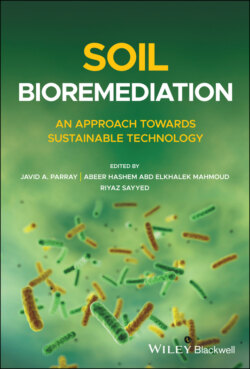Читать книгу Soil Bioremediation - Группа авторов - Страница 13
1.2 Ex‐situ Versus In‐situ Bioremediation
ОглавлениеIn‐situ bioremediation is the removal of pollutants under natural conditions by using microbial potential without excavating for polluted samples [34–36], whereas ex‐situ bioremediation is the degradation of pollutants in excavated samples [37, 38]. There is a noteworthy difference between the two methods of bioremediation, both in terms of experimental control and the end result. While considering the performance of these two methods of bioremediation, it was found that the degradation process in situ is more variable than ex situ [37]. The other significant advantage of the application of an ex‐situ bioremediation method is its independence from environmental factors that could adversely affect the efficacy of the process. Further, “because ex situ bioremediation is carried out in nonnatural environments, the process can be manipulated easily by physico‐chemical treatments of the target pollutant before and/or during the degradation” [39]. In spite of the selective advantages of ex‐situ bioremediation techniques, the in‐situ bioremediation technique constitutes the most widely used technological treatment for the restoration of polluted environments [36, 37, 40, 41]. One‐fourth of all remediation projects make use of in‐situ bioremediation strategies [36]. In‐situ bioremediation technology is less expensive because it does not need evacuation and it also releases fewer pollutants. The other important aspect of in‐situ bioremediation process is its applicability to diverse environmental niches for example, industrial sites, aquifers [42], soil subsurface [43], and groundwater [35, 44]. The significance of in‐situ bioremediation is increased by abundant presence and activity of microorganisms, thereby enhancing the efficiency of the decontamination process even in non‐accessible environments. Ex‐situ bioremediation is carried out by several methods, which are non‐related, e.g., slurry phase bioremediation and solid‐phase bioremediation, which are driven by the physico‐chemical properties of contaminants [45, 46]. In‐situ bioremediation techniques can be categorized as (i) biostimulation or (ii) bioaugmentation [36, 40, 41, 47] and focus mainly on speeding up the removal of toxic pollutants. The choice between the two techniques is determined by: the physico‐chemical characteristics of the polluted area, the presence of co‐contaminants, and the type and concentration of the pollutant, for example. It is suggested that ex‐situ bioremediation methods are useful for the remediation of (i) soils polluted with recalcitrant pollutants in higher concentrations, (ii) soils rich in clay where the permeability of pollutants is low, (iii) sites where conditions are not favorable for biological activities, and (iv) where microorganisms are not released for a range of reasons [48]. The selection of a bioremediation technique based on the expected outcome is very important. The enhanced degradation by in‐situ bioremediation can result in increased contamination of lesser hydrophobic metabolites in the water sources in the vicinity of the source contamination [49, 50].
